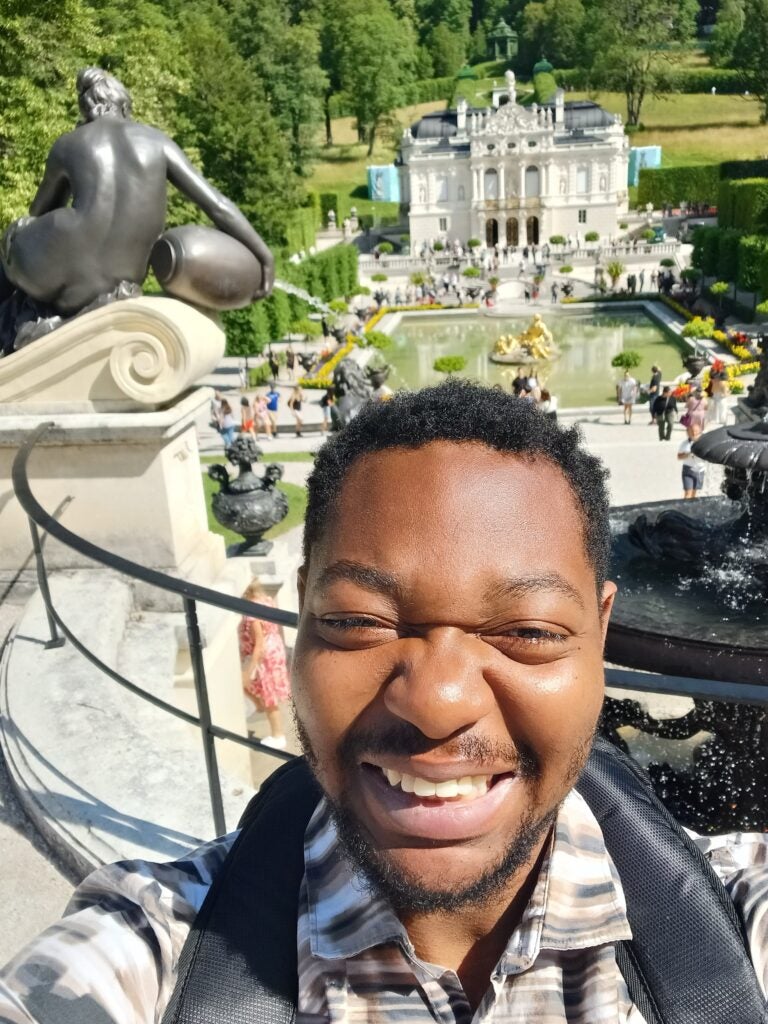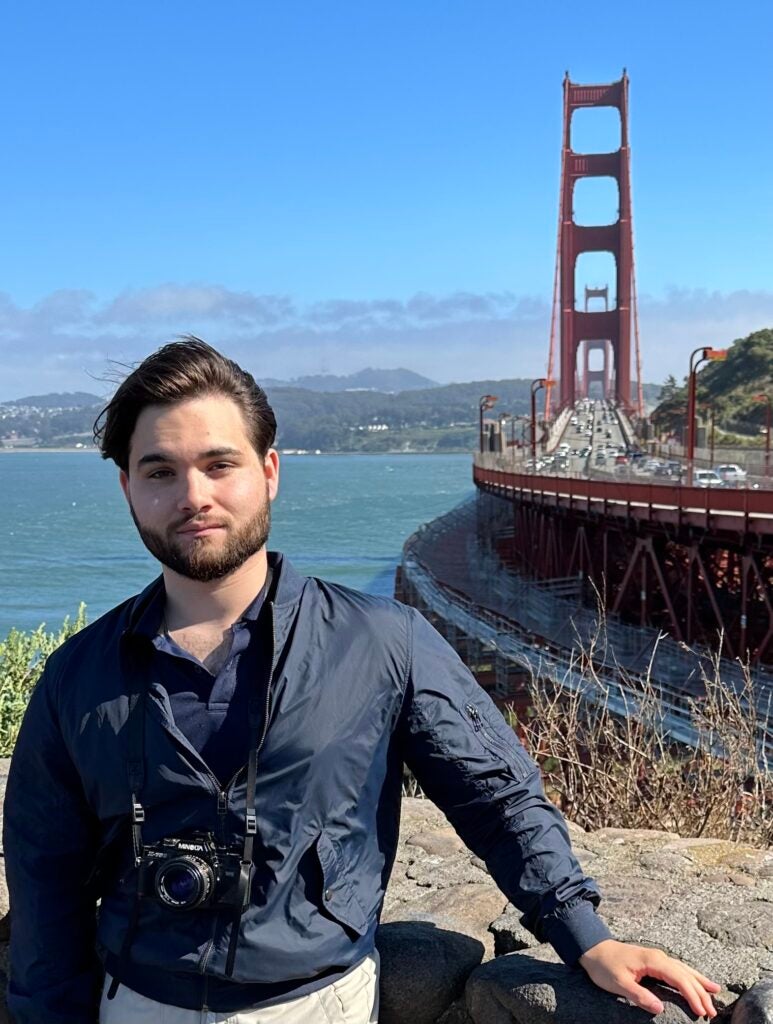Our Students
Learn more about some of the students in our community, what drew them to Global Medieval Studies, and their recommendations for professors and classes within the program!
Kelvin Doe

I wish to express my gratitude for the generous support provided by the GU GMVS travel award, which enabled me to embark on a weeklong journey to Munich and Salzburg. This trip proved to be an enlightening experience, both personally and academically.
During my time in Munich, I had the privilege of visiting the MGH, the largest archive of Medieval Frankish sources. This visit allowed me to engage with primary sources I had previously only encountered digitally. I also had a brief layover in London, where I took photos at tourist spots.
Both Munich and Salzburg are notable for their abundance of castles. In Germany, I explored Nymphenburg Palace, Neuschwanstein Castle, and Hohenschwangau Castle, while in Austria, I marveled at the Hohensalzburg Fortress. There were so many castles in the region that I may have visited others, but it was difficult to keep track.
I explored the English Garden, took a photo at the Staatlicher Tor, wandered around the Olympic Park, and enjoyed many biergartens. Notable highlights included the efficient German U-bahn and S-bahn systems, which made traveling easy.
One of the more impactful aspects of my trip was a visit to Dachau, where I gained a deeper understanding of the historical atrocities that occurred there. I also hiked in the Austrian mountains for a few hours, visited Mozart’s birthplace, and admired the trick fountains in Salzburg.
In summary, I am grateful for the GU GMVS travel award, which transformed my vacation into a meaningful academic and personal experience. These experiences will remain with me, and I look forward to further scholarly pursuits and exploration in the future.
Ian Gould

This summer, I took a road trip to various medieval cliff dwelling sites in southern Utah.
When I first had the idea for this trip, I wanted to see some of the most famous sites of medieval America, like Mesa Verde and Chaco Canyon. Unfortunately, a combination of trip logistics and
park closures made this unworkable, but this only turned my attention to some of the sites further west. I am ultimately grateful for this, as my trip led me to see some of the lesser-known or more off-the-beaten-track cliff dwellings that have contributed to our collective knowledge about medieval American societies.
I began this tour at the Edge of the Cedars museum in Blanding, Utah in order to get more of an informational background with the sites I would be visiting. The museum had an impressive collection of ancestral Puebloan pottery and other artifacts, including a particularly striking sash made out of red macaw feathers. On the museum grounds was an excavated Pueblo village with a large multi-room structure. I later visited a similar-looking site at Mule Canyon.
I visited Hovenweep National Monument, the only site on my trip that is managed by the National Park Service. The circular dwellings were quite well-preserved, but the most striking aspect of this site was the landscape. The structures were dotted around the rim of a canyon, perched right on the edge in a way that, in some cases, looked somewhat precarious.
Hiking the loop through and around the canyon, I was able to see the landscape from many different angles, and by the end, I was struck with the sense of place the whole area gave off. Most archeological sites I’ve had the chance to visit before, including Edge of the Cedars, just kind of seem like something dug out of a hillside. At Hovenweep, however, it was easy to envision the type of community that existed here, with a community of houses ringing this canyon. It’s difficult to put into words, but Hovenweep felt like a true place. The distinctive landscape told more about the shape of the community and how it might have functioned than the stone structures could have ever communicated alone.
My final stop was the House On Fire site near Mule Canyon, so called because the patterns on the rocks above it really do make it look like the structures are on fire. It is easily the most visually striking place I visited. The structures are located well off the road, at the end of a roughly 2-mile hike along a creek through a wooded canyon-like area.
Though the landscape looked quite different than Hovenweep, it communicated a similar sense of place, with the structures wedged into the cliff overlooking the wooded creek, a secluded home in the high desert.
Erik Hoets
William Calderon
The Global Medieval Studies (GMST) program at Georgetown has made my time on the Hilltop edifying and fulfilling. Though I initially was majoring in just Classical Studies, I was quickly drawn to add the GMST program as a second major due to its subject matter and breadth of course offerings. I do not think a double major in two histories is for everyone; however, I do believe adding on GMST as a minor would be a benefit and enjoyment for anyone with interest or exposure to the subject.
Because of the way the program is structured, students have the freedom to enroll in various classes from across numerous departments, such as my home Department of Classics to the Department of Art History, Department of English and, of course, the Department of History. Given the global focus of the program, students are able to step outside the realm of the West and learn about cultures and histories they otherwise may not know anything about. I have met some of my favorite professors and friends in the medieval field at Georgetown and am eternally grateful for its exceptional course offerings, faculty, and existence.

Thomas Ronan
Thomas Ronan (COL ‘23), a Global Medieval Studies program alumnus, is spending a gap period between college and law school working as a high school English teacher in Nara Prefecture, Japan. Thomas has been interested in the Japanese Middle Ages since childhood, and living and working in Japan was a long-time goal of his. Needless to say, he is enjoying his time there to the fullest and taking every opportunity possible to visit historic sites across the country. Below is a list of his top five favorites.
1. Kenrokuen (Kanazawa City) (1840s)—Destroyed in a fire in 1759, Kenrokuen, the Maeda Clan’s private park, underwent a lengthy restoration process until the 1840s. Ranked among Japan’s “Three Great Gardens,” the sprawling Kenrokuen’s striking vistas are sure to impress any visitor.
2. Himeji Castle (Hyogo Prefecture) (1609)—an early modern fortress considered by many to be the most beautiful castle in Japan, Himeji Castle is unique in that unlike most Japanese castles, it has never been destroyed by war, fires, or natural disasters, and that thus, its appearance has not changed since its last expansion (1609)
3. Shirakawago (Gifu Prefecture) (19th Century)—a preserved historic village in the Japanese Alps that once served as a center of gunpowder production, Shirakawago is known for its unique Gassho-style houses.
4. Horyuji (Nara City) (607)—the Buddhist temple Horyuji was commissioned by Prince Shotoku, a nobleman accredited with the spread of Buddhism in Japan in the Asuka Period, the creation of the first known Japanese literature (his commentaries on Buddhist sutras), and that of Japan’s first code of law, the Seventeen-Article Constitution. The Horyuji Pagoda (right) is the oldest wooden building in the world.
5. Ginkakuji (Kyoto City) (1490)—a Buddhist temple commissioned by the Shogun Ashikaga Yoshimasa. Thomas recommends viewing Ginkakuji’s famous pavilion and “Moon-Viewing Platform” sand construction from across its “Sea of Silver Sand” garden (view pictured above). In Thomas’s words, “the temple’s sublime atmosphere is unparalleled.”

Graduate Students
Bryna Cameron-Steinke
Bryna is a fourth-year PhD candidate at Georgetown’s History Department studying early medieval environmental history. Her dissertation research examines land use and land transformation in northwestern France, focusing on coastal Brittany and Normandy, between 300-1000 AD. Bryna is from Toronto, Canada, and before coming to Georgetown, she completed a BA&Sc at McGill University, where she studied Biology and History, and an MA from the University of Toronto’s Centre for Medieval Studies. In undergrad, she was interested in the intersection between biology and history, which eventually led her to environmental history. Bryna’s research is profoundly interdisciplinary, using evidence from archaeology and palynology, the study of plant pollen and spores, in addition to traditional written sources. Though her background is in history, she’s sought out training in these other fields. For archaeology, for instance, she’s studied archaeological theory and participated in the excavation of an early medieval infant cemetery, thought to be the result of a malaria epidemic, in Lugnano in Teverina, Italy, in 2019. She’s also planning to train in palynology. Since there are relatively few surviving written sources from the early Middle Ages, Bryna thinks an interdisciplinary approach is particularly valuable for this period. She hopes that her research will help show the potential of interdisciplinary research for medieval history. Otherwise, when she’s not reading pollen diagrams and Latin charters, Bryna loves getting outside and going on hikes, runs, and bike rides around DC.


